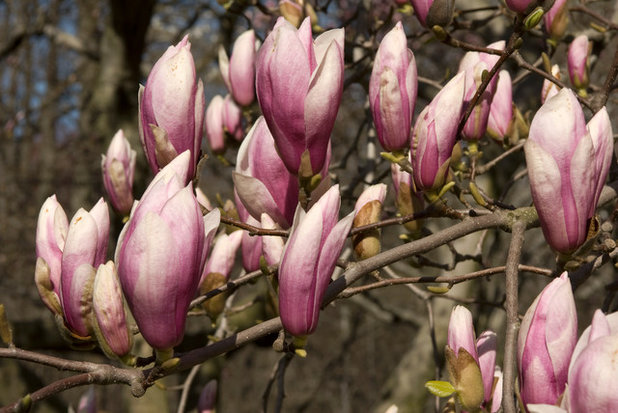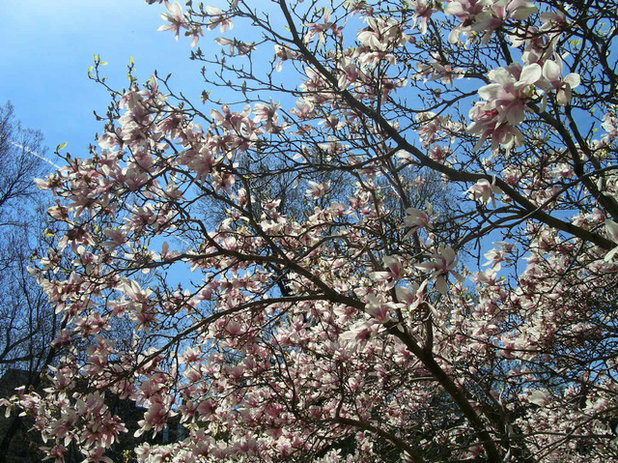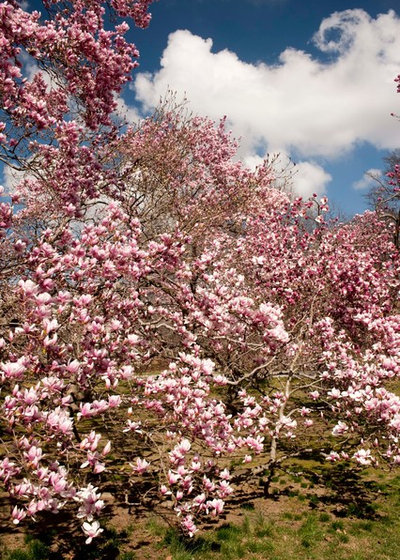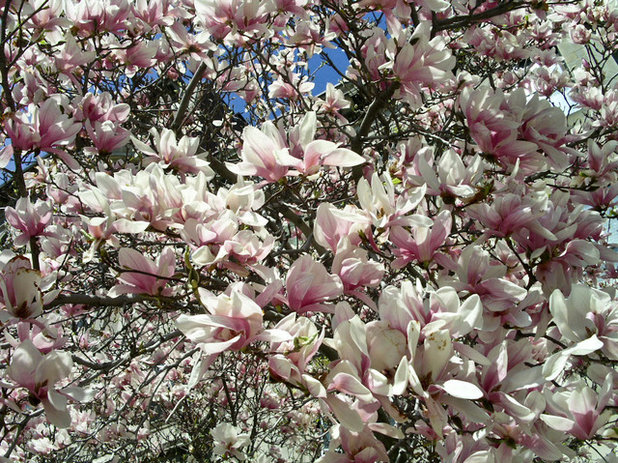A specimen tree that's unique and attractive, and offers year-round interest, makes sense in a garden; it's useful, hardworking and will perform season after season. Saucer magnolia
(Magnolia x
soulangeana) performs most notably in one season — maybe even in just one month — than during the rest of the year, by far. But measure most trees' year-round display against saucer magnolia's short-lived early spring spectacle, and I'd say that this one, famously created by agronomist Étienne Soulange-Bodin, wins out over a year of reliable foliage.
While its delicate and sculptural appearance may imply a finicky and high-maintenance disposition, many find these trees to be surprisingly unfussy and easy to grow with proper care and attention.

The New York Botanical Garden
Botanical name: Magnolia x
soulangeanaCommon names: Saucer magnolia, Japanese magnolia, tulip magnolia
USDA zones: 4 to 9 (find your zone)
Water requirement: Moderate (keep the soil evenly moist)
Light requirement: Full sun to partial shade (prefers morning sun)
Mature size: 25 to 30 feet tall; similar spread
Benefits and tolerances: Blooms attract bees, butterflies and birds; easy magnolia to grow; tolerates clay soil
Seasonal interest: Early, prolific blooms on bare branches
When to plant: Plant it in spring during active growth. (It can also be planted in fall before the frost.)

Matthew Cunningham Landscape Design LLC

The New York Botanical Garden
Distinguishing traits. Saucer magnolia heralds the coming spring as one of the season's earliest bloomers. Flowers appear earlier in milder climates, and later where winter persists. Five- to 10-inch waxy blooms cloud bare branches even before the tree leafs out, emphasizing its spreading, architectural form — one of the tree's most elegant qualities.
Look for fuzzy 1-inch buds as signs of flowers to come. White, fragrant blossoms blush pink and purple as they emerge and open to their namesake saucer shape. Many cultivars have been developed in a wide array of colors and sizes. When the blooms fall, waxy petals temporarily transform the ground into a soft pink blanket.
The tree leafs out after blooming, producing glossy, bright 4- to 6-inch ovate leaves. By late spring the spectacle of saucer magnolia has passed, but that doesn’t mean its value is lost. Foliage persists well through summer, turning yellow and brown in fall before dropping.
While we're all wild about its flowers, the form of saucer magnolia itself makes a beautiful garden focal point. Appreciate its spreading, low branching structure and smooth gray bark until its flowers return again.

Matthew Cunningham Landscape Design LLC
How to use it. Saucer magnolia is the ultimate early-spring accent tree, but remember it's a year-round garden feature. Plant it in a protected area where you can enjoy its blooms in spring, foliage through summer and architectural branching structure over winter.
Cluster multiple trees, but remember the maximum size of the tree and its roots, and consider its mature size when you're planting it. Saucer magnolia reaches soaring heights for a patio tree but is also low branching.
Here, mature magnolias line Commonwealth Avenue in Boston.

PLATEMARK DESIGN
Bring a few flowering magnolia branchlets inside.

Matthew Cunningham Landscape Design LLC
Planting notes. There’s a reason saucer magnolia is used so extensively — it’s one of the most tolerant and easy-to-grow magnolias. But that in no way means it's a low-maintenance or no-maintenance tree. Magnolia trees are investments, of both time and money.
Saucer magnolias are not difficult to grow, but they take time to establish. Be sure to take extra care and pay attention to small details when they are young.
Plant in spring when the tree is actively growing. Fall will also work, but plant at least four to six weeks before the ground freezes.
- Select a site that will protect the tree from harsh winter winds or heat that may cause it to bloom too early in spring. Also be sure it has enough room to grow (look out and up). Magnolias do not like to be transplanted, so you want to get the spot right the first time.
- Dig a hole twice the diameter of the root ball, but don’t dig deeper than the root ball. Magnolias have fleshy surface roots, so you don’t want to cover those too much.
- Be sure the root ball is well watered to make root damage less likely. (The roots will be supple and less brittle.)
- Break up the surrounding soil so it doesn't serve as a root barrier.
- Place the root ball in the ground, maintaing an even space around it.
- Backfill with rich, organic material; water in well and mulch.
- Maintain moist soil. Mulch over to protect the soil from frost.
Saucer magnolia grows moderately to slowly, so don’t expect to see flowers the first year. Be patient and nurturing. In midsummer, after it finishes flowering, lightly clear out crossing and damaged branches. There are no major pests associated with this tree.





